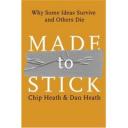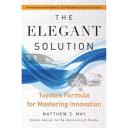What sticks? According to Chip and Dan Heath, the following SUCCES elements are important: 1) Simple, 2) Unexpected, 3) Concrete, 4) Credible, 5) Emotional, 6) Stories.
1. Simple: Example: Southwest Airlines’ “We are THE low-faire airline.” Newspaper’s lead. “If you say three things, you don’t say anything.” Clinton’s slogan, “It’s the Economy, Stupid.”
Simple = Core + Compact
2. Unexpected (pay attention): Surprise gets our attention but interest keeps our attention. Sony’s “Radio in pockets” and Kennedy’s “Walking on the moon” are classical case of unexpected surprises.
3. Concrete (understand and remember it): Use less abstraction but something tangible. Easy to remember. Memory is more like a Velcro. The more hooks an idea has, the better it will cling to memory. Your childhood home has a lot of hooks but a credit card number has only one. The difference between an expert and a novice is the ability to think abstractly. Novices perceive concrete details as such. Experts perceive concrete details as symbols of patterns and insights that they have learned through years of experience – the curse of knowledge. The solution is to find a “universal language,” one that everyone speaks fluently. HP’s Ferraris’ living room designed to show Disney.
4. Credible (agree/believe): Ulcer was discovered by the incredible outsiders, Marshal and Warren, to be caused by bacteria. No one believed them. More vivid details and accurate statistical
numbers may help. Sinatra’s “If I can make it here, I can make it anywhere.”
5. Emotional (care): the case of “sportsmanship.” Appealing to self-interest. Maslow’s hiearchy of needs: 1) transcendence: help others to realize their potential, 2) self-actualization: realize your own potential, self-fulfillment, peak experiences, 3) Aestheic: symmetry, order, beauty, balance, 4) Learning: know, understand, mentally connect, 5) Esteem: achieve, be competent, gain approval, independence, status, 6) Belonging: love, family friends, affection, 7) Security: protection, safety, stability, 8) Physical: hunger, thirst, bodily comfort. “Don’t mess with Texas” campaign is a good example of appealing to individual’s perception of being a Texan.
6. Stories (able to act on it): Subway’s “Jared” story of how he lost 345 lbs. How do spot good stories: 1) The challenge plot (David and Goliath story), 2) The connection plot (good Samaritan), 3) The creativity plot (makes us do something different, to be creative.
Overall, this is a great book outlining the key ingredients to making your idea stick with people. Having all of the these ingredients would help you communicate effectively and stick with people. Excellent book.


